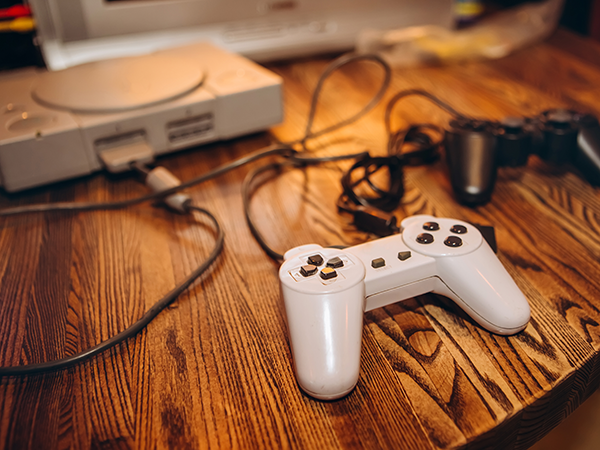
RETRO CABLES FOR RETRO HARDWARE
Share

Want to game on your old PlayStation or watch a VHS? Then you’ll need cables that aren’t compatible with modern devices.
Picture the scene: You stumble upon a first-gen PlayStation at a flea market along with some games. You remember the rush you got back in the ’90s playing Ridge Racer, Final Fantasy 7, Tekken, or Crash Bandicoot. You once sold your PlayStation to make room for more modern hardware, but now you want to relive those good old days. So, you buy the retro console. But annoyingly, the seller can’t provide you with the right video cable. You’ll have to get that somewhere else – but what kind of cable do you actually need? Read on to find out.
Conjure up childhood memories on the screen with old consoles and RCA/phono cables
Hardware of all kinds has evolved and changed significantly over the past 30 years – so much so that modern devices are no longer compatible with older ones. Today, completely different types of cable and therefore also connector types are used than in the days of the PlayStation, VHS recorders, and cathode-ray TVs. An HDMI cable won’t get you far if you want to power up an old Super Nintendo, do a few laps of Mario Kart, or rescue Princess Zelda from the clutches of evil as Link.
No, for old video game consoles as well as retro home computers like the C64 or Amiga you also need old cable technology such as aerial cables for the RF TV output or RCA/phono connectors. But one type of RCA/phono connector is not the same as another. In this case, it’s important to distinguish between composite video and component cables. In the case of the former, you’ll need a cable with only one plug at each end for pure video transmission. But nobody wants to game without sound – so if you don’t already have a suitable audio cable at hand, it’s best to grab a composite video cable with three plugs at each end: Two for audio and one for video. Colour-coded markings prevent you from getting the plugs all mixed up when it comes to plugging them in.

More connectors, better picture
For even better picture quality, grab a component cable and combine it with a RCA/phono stereo audio cable. Then you’ll have three RCA connectors for video transmission instead of just one. With this, you can also enjoy Full HD video (1080i), but you only if the device in question supports this resolution. Just like the composite video cable, each connector is colour coded to make it easier to match it with the right socket.
No matter what type of RCA/phono connection you use, in most cases you’ll need additional adapters. Most old video game consoles have proprietary connectors for video cables. The PlayStation is an exception to this with its standard composite video outputs. Depending on how modern your TV is, you may still need an adapter. Not all of today’s TV sets still have RCA/phono video inputs, with some models only offering HDMI ports.
SCART cables are still up to the job
Besides composite video and component cables, SCART was often used in the past. It’s an alternative to RCA/phono when it comes to retro consoles, especially since SCART – like the component cable – theoretically supports Full HD and can carry audio. You can also use SCART cables to connect an old video recorder to your TV. Maybe you’ve been rummaging through your collection of VHS cassettes and feel like watching one or two again. One important thing to remember is that in this case, too, an adapter is required unless your television is several years old.

